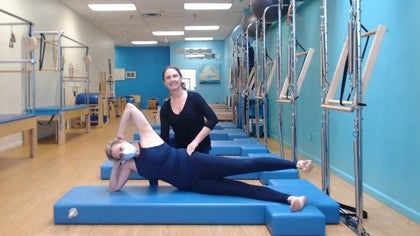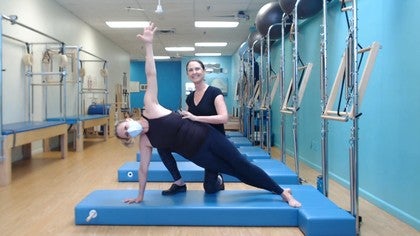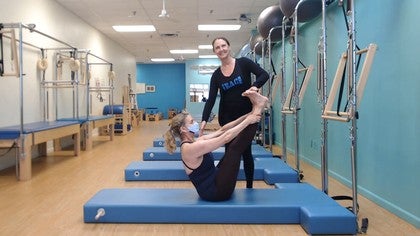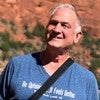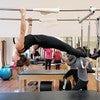Description
About This Video
Transcript
Read Full Transcript
Hi gang. Welcome to the last of our eight part series. Today we're gonna get our cheetah on, as you can tell by the lovely picture right here. We're gonna talk today about kind of the ultimate intention, I think really of Joe's work, which is to move like a natural, normal animal, a wild animal and natural, normal human if that's even possible these days to get as close to that as possible anyway, and my kind of spirit animal of choice for thinking about wild, natural, perfect movement really is a cheetah. And so giving you this fantastic picture of the GL does find that's got many cheetahs in many shapes and the thing to notice is the spines.
Just notice the many, many ways the spines have to reorganize to serve the purpose of the movement they're about to do, right? So a cheetah, when they're running they're hunting prey, they get their eyes locked on the prey and then their brain goes very, I mean who could even imagine how fast to tell their four feet what their four feet have to do to get the prey, right? So eyes on the prize and then four feet doing what the brain is telling them to do and the spine having to be free and flexible and adaptable and capable and not impede, not get in the way of the speed, not get in the way of the quick movements, et cetera. So we've already talked about the spine and the organs that are connected to it, right? And we've talked a lot about our center and our breathing and all of those things come into this, getting your jaw on.
You can kind of see when you look at that cheetah that he's definitely got his jaw on, like powerful chest and strong upper body. But today we're gonna use all of those but mostly kind of focus on if we could get our hands and feet to be amazing, then the process of communicating through our body becomes much, much clearer. So just as a piece of information before we get started, you have 206 bones in your whole body and 106 of them are in your hands and feet. So that's a tremendous amount of motor capability here that your brain like 75% of your motor cortex is for your hands and feet. And if we can get our brain all the way to our hands and feet, everything in between also gets organized.
So if we can just get way out to the ends for what our brain is really for a lot, then the rest of the body organizes relative to that instead of that, so that we don't hold tension, we don't grip, we don't congest anything in the spine in particular. So we're gonna just keep that thought alive as we begin, we're gonna have Sue come in now and I want us to do, just have a seat, Sue. I want us to just do a little bit of just massaging first to stimulate the hands and feet. Okay, so let's just start with our hands, nothing complicated. Just do like you were kind of squishing clay between your fingers.
You feel maybe all of that kind of skin sensation. That's a lot of information for your brain and from your brain and maybe just move your fingers to the other connection. And then let's just each finger, just massage it out pinch the tips a little bit, all the way to the tip. So your brain knows where things are in space, right? And then the other side, you just waking it up but you can feel, I think, just how much sensation there is in the hand, probably more than is in our feet, just because we put our feet in shoes and walk on flat stuff.
So now just take one foot, just bend your knee and take your foot, you got it. And the same idea, just massage it, stretch it, pull on it, wake it up. One thing that's kind of nice to do is take the heel and the ball of the foot and twist it like a dish rag so that you just wake up the thousands and thousands and thousands of nerve endings in your foot that are supposed to tell your brain a lot of things. And also your brain is telling them a lot of things. And we want to have that back and forth as much as we can.
Yep, each toe pulling them, pinching them, just feeling the sensation and making your brain recognize it so that if we can stay more focused all the way out at the ends of our body, then we can maybe release some tension and breathe better, et cetera. Okay, so let's lie down. Now, we're gonna do, let's start with some footwork but we're not gonna do a ton of reps because I want you mostly to just wake up and feel the ends of your body, right? So take an inhale and then exhale and curl on up. Feel your hands around your head and your head in your hands and then feel your feet.
And then we'll just do five each, so out and in and you feel more like the feet are pulling you away from the hands. The hands are pulling you away from the feet. So you feel sort of both ends of your body and then the canoes shape in between. And then when you go bird on a perch, go really nice deep flection of all your toes of your ankles maybe even try to keep your ankles more flexed. You got it.
Nice, so out and in, and then when you go to the heels, really stretch, open your feet, like your focuses, the soles of your feet, the reach through your heels, you got it. So we're reaching way out, stretching the fabric, stretching the toes apart maybe even trying to get your big toes together. And then you can stay out at whatever level you want and point, remember there's 26 bones in each foot. So we got 52 right here. We got 54 over there in the hands.
And all of those bones mean lots and lots of joints lots and lots of nerves, lots of connective tissue lots of blood flow, all kinds of fabulous stuff. And then just say pointed in the us just lower your feet to the floor. Nice, and then rest your head. Take your hands down to the mat. Feel them on the mat for a second.
Feel the whole, maybe backline of your arms. Feel your very active feet. Just take a big inhale and exhale, curl up, just lift your hands and feet. And in two, three, four, five and out. Two, three, four, five, and then and you can relax a little tension in the neck and shoulders tension.
Even in the legs, you can have strong legs. What's the subtle difference we've talked a little bit about the subtle difference between tension and hardness and just fabulous muscle strength. And you can point and flex your feet. I don't think that's a bad idea at all. Just to keep them moving.
Yes. And then last couple. Sue's my counter. And last one. And then down when we go, beautiful.
Okay. If you have a strap, a sandbag, whatever, go for it. If you have a bag, go for it. If you don't flex your feet more than you've ever flexed your feet just the actual strong flection of the foot ankle will stabilize at this end a little bit. And then make sure you've got a really nice grip.
You feel the entire palm on the bar. So you're gonna rise up and you feel your hands follow all the way to your feet and your feet and hands pull apart. Nice job. And in the process, you maybe feel like you can release a little tension in your spine and feel like your spine's flexibility is designed to support what your hands and feet need to do and keeping sensation alive in the hands and feet. Yes, let's do one more, beautiful.
Up and over and back down. And pull deep in the abdominals, yeah. In a way that maybe you couldn't, go ahead and put your back down if you hadn't had as strong a connection to your hands and feet. Okay. So roll over awareness.
Palms press down. Feet rise up, feet go to the floor, open roll back down, keep your feet very strong. So really flex them. Yeah, then you can point, sorry, Sue, and go back up again and just stop, you know, at the height of the mat. And then open and come back down, so you can go lower over here.
In fact, it can be easier sometimes to go bigger range. If you concentrate on what's happening way out at the foot and reverse up. And you put more energy in the feet so that you can take some out of your spine. So as you go over, take a little moment now and even put this over there on your feet. Close your feet and then move back down again moving your feet even more than your legs.
So let's do one last one. Over feet go to the floor and then transfer energy to them and then feel them as you come back down. Nice. Okay. All right.
And then scoot yourself back and I got to get out of the way there and we'll go right foot up to the ceiling. And now take a little moment here. Maybe relax the leg a tiny bit. And Sue has those crazy arches. So we're gonna try to get a little different kind of sensation in there.
So it's not just, you're familiar, whatever that might be but something slightly different. So you wake something up and you're gonna circle. You feel your palms here and your hands over there, and you try to release a little tension out of your spine. So, you know, you're not building tension and you know that your spine is actually reflecting movement and not just resisting movement and exhale come to center reverse all the way to the toes. Can you maybe less ankle, maybe less ankle and more metatarsal.
Yes. Even if you get a little cramp, just play with it a little bit and see if you can wake up a part of your foot that maybe you don't wake up and good. Last one, around and done. Okay, bend the knee, place the foot down. You got it.
Bring up your other leg. And even though it's sort of leggy could we get all the way out to the interesting part. The interesting part, one bone, two bones, 26 bones lots of incredible joints and muscles. And we go, over down around and the hand too is just nice and strong on the mat. It's not lying there.
It's active Exhale around one more and around and against to see if you can it's to keep for her. But see if you can not just do this part of your foot and see if you can do that part of your foot and let's go the other way. And oh, nice. Good job. Yeah, and as you come to this side, sometimes the foot goes a little off the radar, have the foot be what is actually drawing the nice circle and your spine is going with.
And then last one and come back to the center. All right, nice, bend your knees and roll on up. And just know to like this concept works incredibly well on the equipment because more often you have your hands and feet on something. And so when you're on the chair of their former of the tower, you often can really feel a freedom in your spine. That's a little harder to find on the mat because you're not actually touching anything with your feet and hands as much.
So you feel your hands, you feel your feet, relax your spine and you move your hands and feet through space and you feel how, if I don't over like prepare then an override, what might happen if I feel my feet and hands do I feel a little more connection to my center or maybe from my center? Because I'm not over-correcting or over muscling. Good. And then last one. Nice job.
And then can I maybe breathe? That's nice to breathe a little better, right? Okay, so hands down, hips up, lie down and now just focus again. You see how you can feel there's a lot of energy here but we'd like to get it all the way out and we switch hands do something feet, do something and out. And you release your spine a little bit and let the connection of the hands the length of the foot, not just the leg.
Nice job. Connect you into your center a little bit more. Last one and double legs, inhale and exhale and just feel real about it, no shapes. inhale, reach hands and feet, exhale, squeeze them in. Inhale rich, exhale, squeeze them in two more out exhale, nice job out exhale.
And now scissors unpull twice. Switch, pull twice and think less about your legs and more about your hands and feet connecting in a way that allows you to release some tension in your spine and create some sort of auto connection instead of an arbitrary one. And then feet to the ceiling hands behind the head and you put your feet down and you pick your feet up and you put your feet all the way down and you put your feet up. That's nice. And you pick your head up with your hands and you connect it.
That's right. Last time. This one now, the next one can be the trickiest, but stay aware. What are my feet and hands doing, untwist. Bring your foot in instead of your knee.
What if you brought your foot in? It would come up here more and you bring your foot in. Yeah, foot in and that's it Sue. Nice job. Finish your last one.
Good job. Add rollout up. Okay, fill in the boxes. And now you feel these connections, right? This energy has to come all the way through.
Big inhale and then exhale round over and keep the feet and don't stretch your spine too much. Just flex it. What's the difference? Flex your ankles. Flex your spine, go all the way down.
Flex your ankles. Come on and up we come. Yeah, and it's not just your toes. It's your ankle too. And your ankle flexes and you release 10 all that's the spirit.
And then up we come. And last one deep ankle flection doesn't require any spinal tension. Nice, Sue. And back up again, nice. Point your feet.
Bend your knees. Slide your feet in and then think not so much of what happens with your knees, your hips, or your back and a little more. What happens way out in your feet, hands and you roll back and forth. And when you go over, come on over for a sec, come over here. Now think about this as your roll over, put your low back out here on your feet and then come back up, yes.
So you don't hold back tension. You put the tension or the energy, intention out there. And then the center can connect because if you're holding back tension, better, Sue. If you're holding back tension then the center really can't connect. Let's try just some feet together, flex your ankles, nice.
And just stay really aware of your feet and put yourself out in there. That's the way inhale and exhale and try to more and really hold this front of the ankle strength and hold it. Yes, last time. Nice job. Nice job.
There we go. Beautiful point your toes, put your hands down. And then we're gonna Jack knife over and up. And we're going to think, not so much about all this, but way more, about way out here. Put your back up here.
Put your body up on your feet and then twist and just be careful. Sue has to sometimes flex and then take your body up to your feet. Yes, and take them out and around. And that your feet pull you up. Up they go, that's the way, nice.
And your feet pull you up. So your back can relax a little bit. Yes. And your abs have to work more if your feet pull you up really nice. Okay, that's enough of that.
Roll down, come right up. Strong ankle flection. Yeah, maybe less toes and more ankle. You're just exploring, like, what do I do with my feet? And could I do something slightly different?
And you feel your hands and you twist and you feel your hand to your foot base and a big inhale and hand to foot and foot to hand. And how could you, if you really feel it? Give up all this tension? Yes. And instead, exhale your abs.
Let your spine release into the movement. Let it facilitate the movement. Let it help you get there. Yes, and come back up, last one and exhale. You still use lots of abs.
So your spine doesn't feel vulnerable right or left alone, but you don't have to hold tension in the spine. Swing your the legs around and of course, this could be the one that shows us whether we've done it or not a little bit. So you have strong hands and you really want to feel your feet strangely enough. Could you feel something and you see I'm sort of rolling the foot that way, which should help. If you don't hold tension, relax it even more should help this go that way.
So that when you lift, you round around your (indistinct) and your spine is free to be moved. And you feel your toes instead of your tension in your sacrum or tension in your back. And you could even keep on coming up this way, that's the way around my fingers. Yeah, go forward here. That's the way Sue.
Nice, beautiful, stay for a sec. Do a little hip extension so you know, and then do your dive and you can go hands to the side. Yep, or they can stay right under your arm pits. Yeah, feel your hands. Feel them, feel your feet.
Nice job and rest. Okay, let's sit back for a moment just to give you a little break. And now, even though you feel like you might want to stretch it, just relax it. Put it down like it's just a skeleton. Just fold it and let it go so that you're not also holding tension here and then roll back out.
All right, so very strong hands. What if on some level you could release everything until you get to here. So, you know, you're moving your feet and we go kick, kick, switch. ? Kick and switch, kick and switch. ? Okay, not bad.
Good. And your hands are strong and they're pulling you to them a little bit and you're relaxing your sacrum and your spine. And you're feeling ideally the connection that occurs automatically if you don't block it. And then last set and one cheek on the mat. All right, so here's your hands, right?
Feel them, here's your feet and move those two more than other parts and follow them. Kick, kick, kick, and then follow your hands and feet and other cheek, kick, kick, kick and follow your hands and feet. And what if you even kind of let go a little more and just straighten your legs, just straighten them, yes. And come back down. So you don't even put quite as much of an emergency brake on it.
And now when you get here, what if we picked everything up a little bit, your feet and your hands. Softening the elbows a little bit and then pinking up. Yes. Okay, and then go into your last one and feel how if you pick the hands and feet up, way up, and then come back down and rest. And then go ahead and sit back one more time.
Just give yourself a little hush release, give your spine or reminder that it's allowed to relax. It should be relaxed. If you were cheetah, it'd relaxed and you roll on up and you bring your feet out in front of you. All right, it's not that it's not strong, it's that it's not holding tension. It's not predicting that it's gonna have to do something.
It's trying to be more responsive the way a cheetah's spine with this. So go ahead and lie back down, get your sandbags if you have them nice hip width. Yeah, come down just a tiny, a little bit soon. There's not so much tension on the strap that you can't actually just flex your feet. All right, and then hands help you and hands and feet they sort of delineate the length of you in a way, ideally that kind of doesn't it pull you apart but establishes your ends.
So that you could pull your belly in and release your spine. Yes, right. Yes, and abs would then bend you and then you rise up and then before you do this let that go and just pull your hands and your feet apart. And that's a good job. Nice, nice, nice.
Okay, let's actually go into, Where's this gonna do a little shoulder bridge. Okay, so you've got your strong soles of your feet, your strong palms of your hands, you press them down and they initiate the movement. Your spine responds and it keeps coming and it keeps coming and let's take it all the way into extension, right? Because it's free to be extended and then it's free to be rolled back down again. Because the weight and the effort is a little more in the feet.
So it frees the spine to be mobile up it comes and you don't have to hold tension here or here. This can just keep coming up and up and up and up and up and then come back down. And curl, yeah and the spine just frees up. It almost can feel like it reverses itself 'cause it's totally free. You see that in the cheetah but there an extension here and then their inflection when they curl back in and nice job.
And then let's just go into the Jack knife. So you're gonna follow your feet and let your spine be moved a little bit by your feet. And then you lift your spine back down because the energy is out in your feet. Nice, and over it goes. Nice.
And you can again just release your spine and put it up here so I say a nice job. And then last one and over your spine goes for a ride. Yes, that's so much better. And then your spine goes for a ride. Nice job.
Okay, all right, let's do some sidekicks. So we'll turn on the light and pull your box up. Can you grab that? Yep, there we go. Feet her for them to be too far.
Okay, so we've kind of worked on this exercise a little bit because it is challenging. So we're gonna kind of pull ourselves together and feel this connection, whether your hands behind your head or on the mat, and then feel the feet in terms of pulling energy a little bit out to them. So this doesn't feel congested or collapsed at all. And then you're gonna pick your foot up and move your foot. Yes, now flex your foot and move your foot forward and pulling your foot and move your foot all the way back and flex your foot and move it all the way front.
Flex it. Good it go and hold on around. Yes, and when you come to the front go ahead to the front, hold the foot so powerfully, here. So it's less and it's more way out here. And we go around to the back and the spine is free and we go around to the front and the foot is stronger, stronger, stronger.
Flex it. Come on, Sue. The last one around your spine reflects and responds a little bit. That's better and bring your feet together. All right.
It's hard mentioned. Sue's very long. Those feet are far away and we go pick the foot up more than the leg. Pick the foot up, flex it, put it down, pointed, pick it up, flex it, put it down. That's right.
And last one. We'll reverse the foot and flex it. And the flection is more in the front of your ankle and a little less in your Achilles tendon. And you come back down and flex it and pointed, that's right. Flex it all better pointed.
Let's just do one more Flex it and pointed. You got it. Nice to job. Okay let's do parallel lift both legs up again. Flex your feet.
Flex them. Really, it's not a position or a shape. It's an action. Flex them. Okay, keep them flex, turn out and then clap your feet.
Feel them way down there. It's not your legs. It's your feet. Point your feet. Keep your turnout.
And when you point your feet, yeah, point the sole of your foot. Not the top of your foot. Okay, yes. Flex the front of the ankle all the way and then point the sole of your foot. All right.
And parallel and lower. Nice. That's challenging, isn't it? Okay. Now, let's have you stay facing front just because we can see the feet better, I think.
All right. So, and I didn't say much about the hands but feel a little of your, get your jaw on up here. Feel a little of like your body rising to your hands, your hands drawing your body to them and then pick up good. And do it one more time. Soften the knees just for a moment.
Flex the foot a lot instead, like all of the energy that went here put it here and then pick this up. Yeah, and then move that and then point the sole of your foot. Yeah, and then flex it and then point it. Good job. And then flex it.
When your brain gets way out there and starts asking your foot to do stuff instead of what it does automatically more c'mon incl. Yes. Then you can hold tension in your spine anymore. But you do have to organize because to get your brain all the way to your feet everything in between has to pick up the slack. Nice job.
Yes, much better. And last one. And then the whole form of it is actually cleaner. That's the way Sue really nice and bring your feet together. So it's taking us some time for her to even really, really feel it.
So don't be too surprised. So again, that's a little here. What if it was here? Here's where most of the sensation is in the sole of the foot, in the palm of the hand not in the front of the ankle in terms of point. So pointing is all these little muscles under here.
Flexing will be in there. And because of the X dancer in her, pointing is easy from the ankle and flexing is hard from the ankle. And we want flexing from the ankle, yes, flexing, it's not a position is really a movement. Flex it. Yes.
Pointed. Flex it. That's the way Sue, right? So it pulls energy. At least do one more.
Flex it. Right. Great. Okay, parallel lift both legs up, flex them. And again, it's not a movement.
It's not a position or a shape. It's a movement. Turn them out, clap them, keep flexing, flex more. Then when you point it's the soles of the feet, the palms of the hands, right? Not here so much.
Yes. And then flex them big time serious all the way up, all the way. And then point them soles of the feet. Hard, you got it. And rest.
Good, good, good, all right. Come around and lie down. Or actually stay seated for a second. So I think hopefully maybe you're feeling that a little bit too as Sue works her way through it. It is challenging.
We don't even realize we're not there. You know, and there's more and there's more and there's more down here and as we get all the way to the souls and the palms we give up tension here and then abdominals can contract and the spine stays free. Instead of holding tension in the spine we pull the energy out a little bit more. So we're gonna point the toes. You got it.
Hands are down. Nice, strong hands. You're gonna curl back and pick your arches up. Nice. Feel your palms, less arms.
Feel your palms. Feel your souls, roll down and then try to touch with your palms, yes. A little less stretching, a little more moving. Yes, so you can breathe. That's nice, Sue.
Really nice. And then you put your feet down you pick your feet up beautiful feet down feet up. Fabulous, fabulous, fabulous. Take it all to the floor and let's just do one up we come. Up we come and then you lift your hands and you lay it all the way down.
Nice. Different. Yeah, it's nice. Yes, really nice. Okay, so you can do your hip circles with your hands like this.
You can also put them straight behind you but we're gonna think about not even so much our knees, but our feet. And again, that's the souls. There's 11 intrinsic muscles just in the foot not to count all the muscles that go up your path and you feel that maybe you feel like you're holding a little log, like a bird on a perch. You're holding a branch and you're moving the branch versus you're swinging the branch. You're moving it.
And then you're bringing it here. Exactly, you're moving it. Beautiful. Beautiful. And it calms the nervous system.
So you're actually can focus. And you're like, Oh my gosh, I am aware of my feet. And my body is doing what my feet are asking me to do. Nice job. Okay, and then swing around and lie on your belly.
You know, the extension stuff can be more challenging because in a way it's, you know, behind you can't find your feet as easily, even your hands. So you're down here, you're gonna pick those up and you're gonna pick these up and they pick you up. And you almost can in a way, kind of hang off of them. What if your feet and your hands did more your spine did less and you actually could then get better matter movement exactly. And then exhale and down.
Now, tuck your toes under, feel your feet, pull your hands under your armpits a little bit closer to your waist. Peel them. You're gonna stand on them. You're gonna push with your hands and rise up. And you're not gonna do this part.
You're gonna relax in here. You're gonna make your feet and your hands hold you up. You're gonna relax in here a little bit too. A little bit more. Yeah, look up with your head, but relax your spine.
Let your spine rest on your abs. Hold your hands and feet. Point one foot, pick it up, put it down and flex it. Pointed, pick it up, put it down and flex it. Pointed, pick it up, put it down and flex it, yes.
And this is a little more of the archival version. Good. And you keep checking in. Could this rest, could your feet and hands hold you up. Just like a cheetah.
Put it down, put it down right here. Drop it. Yes, hold your abs. That's the way. And last one.
Nice. Okay, and bend your knees nice. It really begins to show in some of this, arm standing stuff that we're actually holding so much tension here. We're like barely on our hands and feet. Whereas the cheetah is literally just gonna be on our hands and feet just beyond them.
Let them hold you up and see if you did that. If you didn't predict everything you need what might actually fire instead. So that's kind of the goal a little bit is to allow the natural thing to occur that would occur if we truly stood on our hands and feet better. Okay, let's do what should we do boomerang? Let's do boomerang.
Now because it especially in the sort of classical version versus the archival original version, there is that crazy balance, Where you do the rowing arms. And so if you're more aware of where your feet and hands are such that you don't have to grip and hold tension over you move your feet more than even your legs. You come up and here's your feet. They stay, your brain stays with them, stays with them. You flex your spine and you come back down and then you put your hands on your feet for a second.
Like just feel them. There we go. There they are. And then roll up, pick your feet up. Open and close your feet.
Rise up to your feet. Yes. Ah, nice job. That's the way, Sue, beautiful. And then no tension, but lots of control.
And again, pick the feet up. And if you really picked your feet up and I'll show you when she gets there again and go back down. So now here you roll back up, pause for a second. So what happens come back up is that you're basically leaning on your spine. To pick these up would require, right?
And so maybe you make them a tiny bit shorter but you pick them up here and you pick them up here as you hold them. Don't shift them to your sacrum, hold them in your abs. She might need to just stick your butt out a little bit. Yes. And then come back up and hold it in your abs.
Less arms even. Yeah, circle. So you've got these powerful things out here that require your abdominals exactly and around, nice job. Okay, let's do seal. Same idea, right?
So here's your feet. They move and to move your hands and feet, you have to have a center but you don't actually prepare your center so much as you get really connected to your feet. And when you come up, go even let's go really a strong prayer foot and pull it apart a little bit. Yes, make them talk to you. There we go, Sue.
That's the way out here and you are focused on a beautiful way out here. Don't sit on them, like put them out here and move them. Yeah, so this has to connect. Hopefully you can kind of see that 'cause I think that's actually pretty visible for her. So if we come out here and we pull them away so she has to look over sacrum a little bit and do this movement and then move those guys, that's right.
Exactly. And then put them here. And that's the way though. That was good. Yeah, excellent.
Okay, enough. All right. Let's swing around on your belly. Now this one, again, get into these extension ones. It's easy to hang.
We're not hanging. We are trying to connect. And so it might be kind of nice for some of you to actually flex, okay? Bend your elbows a little bit and then move your feet and your hands. And don't stretch yourself.
Just pick yourself up. Pick yourself up. Yes, pick your feet and hands up. That's the way. So that you're not hanging you're actually picking yourself up and then you're free to rock.
Versus can you show the other things too? Yeah, where you're hanging off. So instead if we actually and if ultimately you could do it with pointed feet too, but might be easier. And then yes, you actually connect and pick everything up. Beautiful.
Beautiful. And then rest. Really, really nice. All right, and sit back for a second and then we'll bring your feet out in front and we're gonna do control air desk. All right.
So yeah, give yourself some room above your head because it's a foot to hand connections. We want to make sure your foot's on something, right? So you're gonna jackknife over, follow your feet up. Relax your sacrum and put your feet up here. Tell them to go.
That's right. Put one foot on the floor and hold it with your hands. You got it. It's harder because this isn't the center that we have. Okay, so now make your feet do it.
And not this. Stick your butt out a little bit. Yes. And put one foot down and then switch your feet, not your sacrum, switch your feet. That was so good.
Switch your feet. Beautiful job. Switch your feet, switch your feet. Be even, and then you're gonna roll yourself down and can come up to standing and just be careful of your space. We're gonna do one pushup and we're gonna finish with the big twist.
So hopefully, yes, you've done all these exercises before but we're really trying to reframe them and see if you could find a connection to your center by your abs that is not tension in your spine because you feel and trust your hands and feet. So let's actually just go straight down. This is more the archival version. You just go straight down. You put your hands there, stay for a second.
Put your hands down, put your back on your feet and hands. Just let it be soften the knees a little bit. Then put your weight on your hands and walk forward. Put it on your hands. Yes, nice job.
Drop it. Seek your butt out a little bit, yes. Walk your feet forward a couple of inches. Yes, so you're over your hands, right? Relax your back.
Hold your feet. Your hands, relax your back. Set it down. Stick your butt out. Yes, bend your elbows and straighten them.
Yes, the legs of your body, your feet and hands right now. Like if you were a table, they have to do the work. Yes, otherwise we're kind of faking it. Then when you go to curl, you just pick your belly up. That's all.
And then you keep your weight on your hands and you walk back. So the weight is not in your sacrum. Mandarin is a little so you can pull your belly up. Nice. Okay, we're gonna finish with the grand finale of the big twist.
Some of you might not know the big twist so you're welcome to watch it a couple of times. Now it's a little trickier on a sticky man. So you're welcome to move to the floor. Sue's gonna demo on the mat but just know that feet don't slide as well. Bring them a little narrower.
Just don't even go for big, start small. You're gonna let your feet hold you up. You're gonna feel your hands. You're gonna release tension and let your feet hold you up. Then your feet are gonna levitate.
You're gonna pivot 180 I don't want her to fall off the map. Now here you go. You're going to put your weight on your feet. All of it. Yes, there we go.
Bend the front knee quite a bit. Relax this leg a little, yes and twist. And the head will go down and reach for the ankle. Now you reach to me, right? So you're gonna reach over your back foot like that.
And then you're gonna let your feet hold you and come back to center. Watch the feet 'cause they're really the dictators of this whole thing. She has to get 180 degrees around. So even this foot could move over there more, that's right. Okay, then all of this goes to the feet.
And so you could relax just a little. It's not that it's bent. She just has a tendency to overwork that a little bit and put your weight on your front foot. Really make it, hold you up. That's the way.
Okay, and then you continue to reach over there and you come back up. So we'll try it again. So start narrower smaller. Because when you pivot, they tend to get a little wider. So she's gonna pivot both feet turn all the way around.
All your weight goes on your front leg put your weight on your feet. That's right. So that you can twist. Then you put it on your feet. You reach your hands to me and then you come back up and center.
And that, whoops, sorry. It's harder on the sticky to say that. And then we're gonna twist the other way feet pivot all the way around. Keep pivoting even a little bit more here. Put all your weight on this leg, relax the back leg a little bit.
Relax your spine and put your head down on your shape. And then you're gonna reach out and then come back up and your feet. Hold you, that's okay. Definitely I have to say much harder and then just bring your feet together and finish. Cool, okay.
And the goal being, hopefully by now you kind of figure that out, right? Is that if we can get it out here, then we don't have to hold so much right here and then this can respond. It can twist, it can bend, it can flex, it can extend spinal but also all the muscles, all the organs so that we don't just build tension all the time which is something that's not hard to do in Pilates. So, but not exactly the point ultimately. So anyway, the point is peace, universal peace through having a healthy, natural, normal healthy human body that operates very much like it once did when it was primal and free and didn't sit in the chair and look at a computer all day.
Okay, so let's return to the point. All right, thank you everyone so much for joining Rachel and me for all eight of these sessions, I hope you saw some of the continuity of the themes, I tried to take from Rachael's topics to create some more, you know, metaphorical ways of looking at the movement so that you could put both the mechanical stuff in with a little bit more imagery and whatever works works. If it's for the ultimate point of universal health and international peace. Thanks for coming.
Mechanics and Metaphors: with Amy Taylor Alpers
Comments
You need to be a subscriber to post a comment.
Please Log In or Create an Account to start your free trial.
